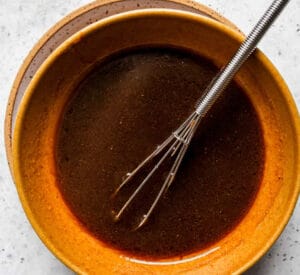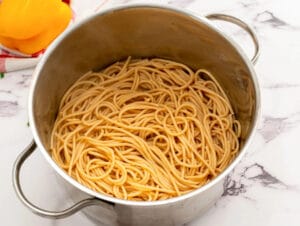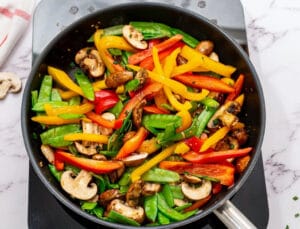Learn how to make vegetable lo mein at home with this flavorful noodle stir fry recipe packed with textures and flavors.
Greetings, friends! This is James Anderson coming to you from Food And Meal. As many of you know, I have a deep passion for exploring new cuisines and flavors from around the world. Lately, I’ve become quite enamored with Asian noodle dishes. There’s just something so comforting about a bowl of steaming hot noodles coated in a flavorful sauce.
In particular, I can’t seem to get enough vegetable lo mein noodles! Now, I know some of you might be thinking – lo mein, isn’t that just like any other noodle stir fry? Well let me tell you, the texture of these chewy, supple noodles paired with the sweet and savory sauce is truly something special. Plus, loading it up with fresh vegetables adds a wonderful crunch and pop of color.
I first tried this Asian noodle dishes from my local Chinese takeout spot and absolutely fell in love. But being the curious chef that I am, I needed to learn how to make vegetable lo mein like chinese restaurants at home. After testing a few recipes, I’ve honed in on what I think is the ultimate vegetable lo mein. I’m so excited to share this recipe with all of you!
The main reason I wanted to develop this recipe was to create a healthier weeknight meal for my family. As much as we love takeout, all that sodium and oil isn’t doing us any favors. My veggie lo mein uses just a touch of oil and features a lighter sauce made with low sodium soy sauce. It’s still packed with flavor but much better for you.
I hope you’ll give this easy vegan lo mein a try soon. Slurp up those noodles and savor all the textures and flavors! If you do make this recipe, let me know. I’d love to hear your thoughts!
Now, let’s learn how to make vegetable lo mein like chinese restaurants!
How to make vegetable lo mein
Vegetable Lo Mein is a quick and easy meal that can be prepared in less than 30 minutes. It includes a savory sauce, vegetables, and soft, chewy noodles. This recipe is great for sharing with friends and family. It can also be made in advance and served with your favorite hot sauce. It is delicious on its own, but you can also add sesame seeds and green onions to add more flavor.

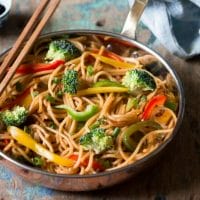
Vegetable Lo Mein
Ingredients
- ½ cup snow peas
- 3 cups baby spinach
- 1 red bell pepper
- 1 carrot
- 8 oz. egg noodles
- 2 cloves garlic
- 2 cups cremini mushrooms
- 1 tablespoon olive oil
Sauce
- ½ teaspoon ground ginger
- ½ teaspoon Sriracha sauce
- 2 teaspoons sugar
- 1 teaspoon sesame oil
- 2 tablespoons soy sauce
Instructions
- Set down a bowl full containing the sesame oil, sugar, soy sauce, ginger, and Sriracha sauce.

- Heat the egg noodles as per the package directions in a large pot of water; rinse well.

- In a medium saucepan or skillet, heat the olive oil over medium heat.

- The garlic, red pepper, and carrot are added to the pan.

- Mix in the snow peas, mushrooms and spinach for around 2-3 minutes or until the peas have ripened.

- Toss in the egg noodles with the soy sauce combination and toss gently to blend.

- Serve right away.

Video
Notes
Nutrition
© Food And Meal
This website provides approximate nutrition information for convenience and as a courtesy only. Nutrition data is gathered primarily from the Spoonacular Database, whenever available, or otherwise other online calculators.
Easy Vegan Lomein in an Instant Pot
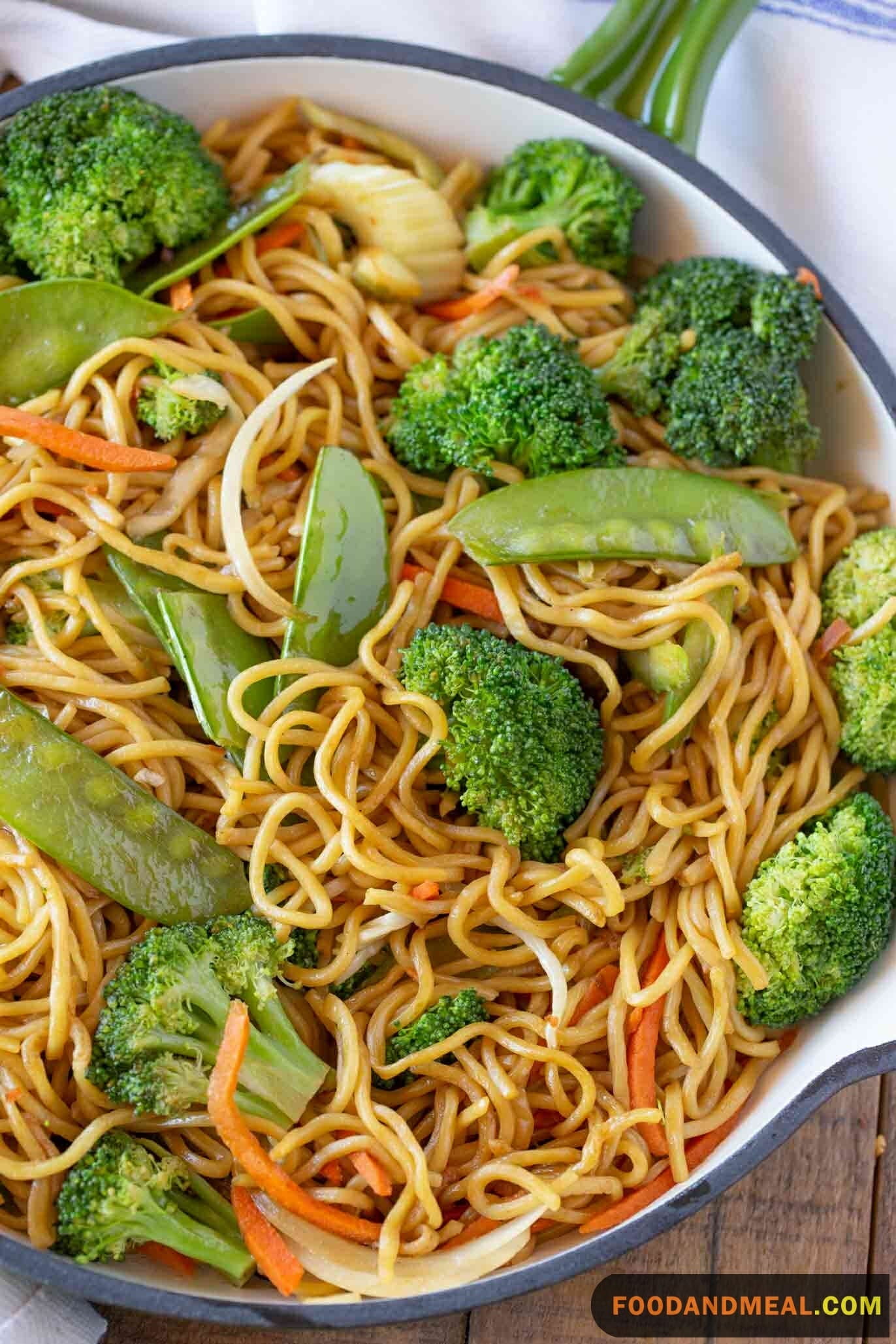
Ingredients:
- 8 oz of lo mein noodles
- 1 tablespoon oil (vegetable or sesame)
- 1 cup sliced bell peppers (red, green, or both)
- 1 cup sliced carrots
- 1 cup broccoli florets
- 1 cup snow peas
- 1/2 cup sliced mushrooms
- 2 cloves garlic, minced
- 1/4 cup soy sauce
- 1 tablespoon oyster sauce
- 1 teaspoon sesame oil
- 1/2 teaspoon grated ginger
- 1/4 cup vegetable broth
- 1 teaspoon cornstarch
- Sliced green onions for garnish
- Sesame seeds for garnish
Instructions:
- Set your Instant Pot to the sauté function. Add oil, then stir in the garlic, ginger, and all the sliced vegetables. Sauté for about 2-3 minutes, until they start to soften.
- In a separate bowl, whisk together the soy sauce, oyster sauce, sesame oil, vegetable broth, and cornstarch until smooth.
- Pour the sauce mixture into the Instant Pot, and give everything a good stir.
- Break the lo mein noodles in half and place them on top of the vegetables and sauce. Do not stir.
- Close the Instant Pot lid, ensuring the valve is set to the sealing position. Cook on high pressure for just 3 minutes.
- Once the cooking time is complete, carefully perform a quick release of pressure.
- Open the Instant Pot and stir everything together. The sauce will thicken as it combines with the noodles.
- Serve your Vegetable Lo Mein hot, garnished with sliced green onions and sesame seeds.
How to make Lo Mein Sauce
The sauce in Vegetable Lo Mein is a symphony of flavors that brings the entire dish to life. It’s often a secret blend, but typically includes soy sauce for its umami depth, oyster sauce for a touch of sweetness and complexity, and sesame oil which adds a nutty aroma that’s instantly recognizable. Garlic and ginger are also key players, contributing their pungent and spicy notes that awaken the senses. A hint of sugar balances the sauce, rounding out the flavors and creating a savory-sweet harmony that clings to the noodles and vegetables.
This sauce is not just a component; it’s the soul of the dish, teaching you how to make Vegetable Lo Mein like Chinese restaurants. As it mingles with the array of vegetables—crisp bell peppers, earthy mushrooms, sweet carrots, and tender snow peas—it enhances their natural tastes while uniting them under one delicious banner. The beauty of this sauce is in its versatility. It can be adjusted to suit personal preferences, whether you like it saltier, sweeter, or with a spicy kick.
When the sauce coats the soft, chewy lo mein noodles, it transforms the dish into a comforting, satisfying meal that’s both nourishing and indulgent. It’s the kind of sauce that makes you close your eyes with the first bite, as you savor the rich tapestry of flavors that dance across your tongue. It’s no wonder that Vegetable Lo Mein, with its delectable sauce, is a dish that many turn to for both its taste and the warmth it brings to the heart.
About Lo Mein
What is Lo Mein
Lo mein, a dish that has woven its way into the hearts of countless food enthusiasts around the globe, is more than just a meal; it’s a delightful experience. The term itself, originating from the Cantonese language, translates to “stirred noodles,” which perfectly encapsulates the essence of this beloved dish. With each bite, one can sense the cultural richness and the culinary artistry that has been passed down through generations.
The magic of lo mein lies in its simplicity and versatility. At its core, lo mein is a harmonious blend of soft, chewy noodles, typically made from wheat flour and eggs, similar to Italian pasta. These noodles are the canvas upon which a myriad of flavors and textures come to life. Whether they’re paired with succulent pieces of chicken, beef, pork, or shrimp, or even a medley of vibrant vegetables, the result is always a comforting bowl of goodness that satisfies the soul.
What sets lo mein apart is the texture of the noodles—thicker and more hydrated than their chow mein counterparts, they possess a plush, chewy quality that makes them utterly irresistible. As you twirl them around your fork, they seem to dance with the other ingredients, each strand generously coated in a savory sauce that’s often a secret blend of soy sauce, oyster sauce, garlic, ginger, and a hint of sugar. The noodles are soft and supple, a testament to their higher hydration, and they carry with them the flavors of the dish in a way that’s both subtle and profound.
The cultural significance of lo mein cannot be overstated. In China, noodles symbolize longevity, and as such, they are a staple during celebrations like birthdays and the Chinese New Year, where they’re served as a wish for luck and a long life. This tradition adds an emotional depth to every mouthful, connecting those who partake in the dish to a history and heritage that is both ancient and alive.
As someone who revels in the joy of cooking and eating, I find lo mein to be a dish that never fails to bring comfort and happiness. It’s the kind of meal that invites creativity—you can throw in your favorite vegetables, experiment with different proteins, and even play around with the sauce until it sings to your palate. If you’re wondering how to make vegetable lo mein like Chinese restaurants, the key lies in capturing the essence of the rich, secret sauce that defines this dish.
In a world that’s constantly rushing by, sitting down to a plate of lo mein feels like a pause, a moment of pure enjoyment where nothing else matters but the flavors unfolding on your tongue. It’s a reminder of the simple pleasures in life, a dish that, no matter how many times you return to it, always feels like coming home.
Difference between lo mein and chow mein
Vegetable lo mein vs chow mein, two titans of the Chinese culinary world, often find themselves in a delicious duel on the dinner table. Let’s unravel this noodly enigma with the wisdom from our memory trove.
- Chow mein, which translates to “stir-fried noodles,” is known for its characteristic crispiness. The noodles are parboiled and then stir-fried until they reach a golden brown crunchiness that’s music to the ears and a party in the mouth. They’re typically thinner and less hydrated than their lo mein counterparts, giving them that irresistible crunch that can turn any frown upside down.
- On the flip side, lo mein, or “stirred noodles,” is the softer, more tender sibling in this noodle narrative. These noodles are fully cooked to a soft and supple state before being mixed with a variety of ingredients and that oh-so-scrumptious sauce we just can’t stop raving about. Thicker and more hydrated, lo mein noodles have a plush, chewy quality that makes them utterly irresistible, like a warm hug from an old friend.
Vegetable chow mein vs lo mein ? So there you have it, my curious connoisseur! Chow mein brings the crunch, while lo mein brings the comfort. Whether you crave the crispy bite of chow mein or the tender embrace of lo mein, both dishes offer a delightful journey through the rich tapestry of Chinese cuisine. And remember, no matter which one you choose, you’re in for a treat that’s sure to stir up some joy in your belly!
is veggie lo mein vegan ?
The traditional sauce for Vegetable Lo Mein typically includes oyster sauce, which is made from oysters and therefore not vegan. However, the versatility of the dish means that it can be adjusted to suit different dietary preferences. If you’re seeking a vegan version, you would need to ensure that the oyster sauce is replaced with a vegan alternative, such as a mushroom-based sauce or simply omitted. The rest of the ingredients in Vegetable Lo Mein, such as the noodles, vegetables, and other sauce components like soy sauce and sesame oil, can be vegan-friendly. So, while Vegetable Lo Mein can be made vegan, it’s important to check the ingredients or request a vegan preparation when ordering or making this dish.
Tips about Vegetable Lo Mein Recipe

Cooking Notes
- Use High Heat: When stir-frying, a hot wok or pan is essential. High heat ensures that your veggies stay crisp and don’t turn mushy.
- Prep Ahead: Have all your ingredients sliced, diced, and ready to go before you start cooking. Stir-frying happens quickly, so having everything at your fingertips is a must.
- Noodle Control: Cook your lo mein noodles until they’re just shy of al dente. They’ll finish cooking in the wok, preventing them from becoming overcooked.
- Sauce Savvy: Don’t overdo it with the sauce. Too much can make your dish overly salty or soggy. Start with a little and add more if needed.
- The Wok Workout: Keep the food moving in the wok. Continuous stirring helps to distribute heat evenly and prevent sticking.
- Overcooking: Don’t overcook your vegetables. They should remain vibrant and slightly crisp, not soggy.
- Soggy Noodles: Avoid overcooking noodles before stir-frying. Cook them just until they’re almost done to retain the perfect texture.
- Crowded Wok: Overloading your wok can lead to uneven cooking. Stir-fry in batches if needed.
- Over-Saucing: Adding too much sauce can make your lo mein overly salty and mushy. Start with a modest amount and adjust to taste.
- Skipping Fresh Ingredients: Fresh garlic, ginger, and vegetables make a world of difference. Don’t substitute with dried or powdered alternatives.
Serving Suggestions about lo mein noodles
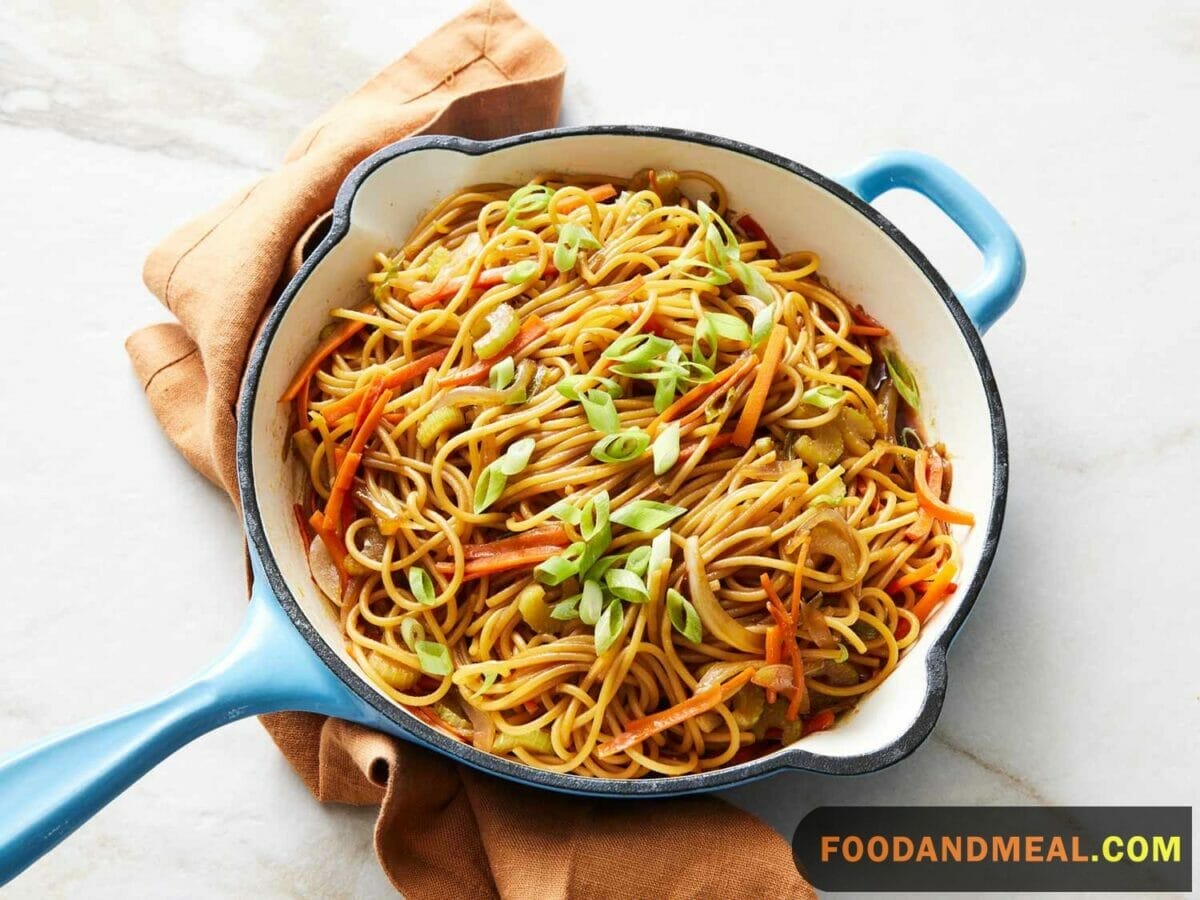
This vegetable lo mein would pair nicely with some grilled or pan seared proteins like teriyaki chicken, beef, shrimp, or tofu. You could also serve it alongside other Asian-inspired dishes like potstickers, egg rolls, or spring rolls for a more complete meal.
For a heartier bowl, try topping the lo mein with a fried egg or some chopped roasted peanuts. A sprinkle of sesame seeds and sliced scallions would also make for a nice garnish.
I like to round out a meal featuring this veggie lo mein with a bright, fresh salad or slaw on the side. The tangy crispness balances beautifully with the savory noodles. Steamed rice or zucchini noodles would be another simple starch to consider.
You could also turn this lo mein into more of a one-pot meal by stirring in some cooked ground meat like turkey or beef, chopped chicken, or extra vegetables like broccoli, carrots, snap peas, or water chestnuts. The possibilities are endless!
Top 9 lo mein faqs
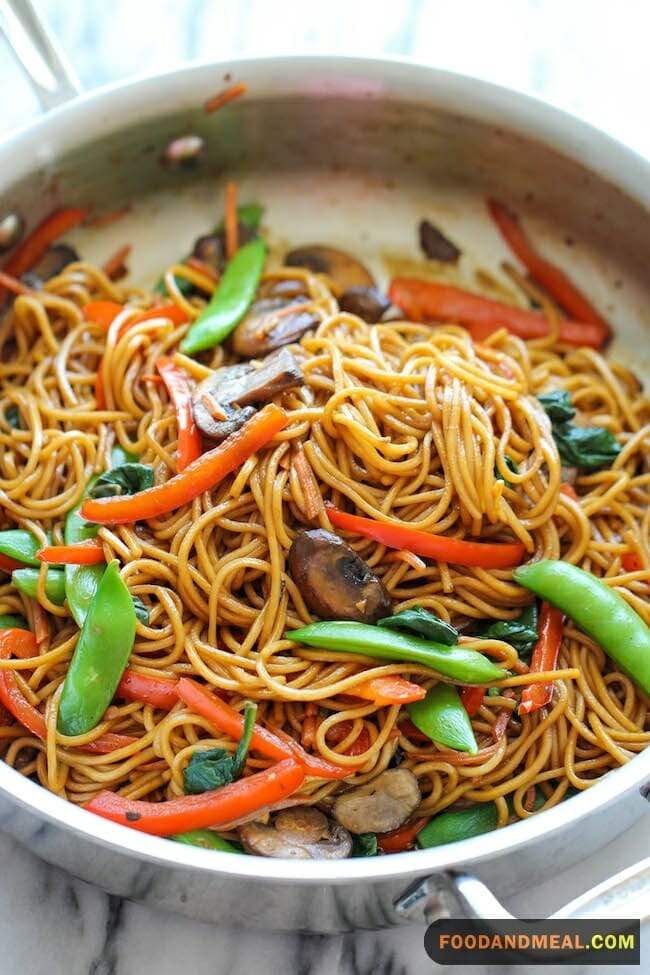
1. What is lo mein sauce made of?
- Lo mein sauce typically consists of soy sauce, oyster sauce, sesame oil, ginger, garlic, and sometimes sugar or honey for sweetness. The combination of these ingredients gives lo mein its distinctive flavor.
2. What makes lo mein taste like lo mein?
- The unique taste of lo mein comes from the specific combination of savory soy sauce, umami-rich oyster sauce, aromatic sesame oil, and the infusion of flavors from garlic and ginger. These ingredients work together to create the signature taste of lo mein.
3. Can you use regular noodles for lo mein?
- Yes, you can use regular noodles for lo mein. While lo mein noodles are commonly used, you can substitute them with other types of noodles like spaghetti or linguine. Just ensure that the noodles are cooked al dente before stir-frying with the other ingredients.
4. Is vegetable lo mein healthy for you?
- Vegetable lo mein can be a healthy option as it contains a variety of vegetables. However, the overall healthiness depends on factors such as the amount of oil and sauces used. To make it healthier, consider using whole wheat or alternative noodles and controlling the quantity of oil and sauces.
5. Can I Make Vegetable Lo Mein Ahead of Time?
- Absolutely! Vegetable Lo Mein reheats well, making it a great option for meal prep. Store it in an airtight container in the fridge for up to 3 days.
6. Can I Make Vegetable Lo Mein Gluten-Free?
- Yes, you can use gluten-free lo mein noodles and replace soy sauce with a gluten-free alternative. Just be sure to check the labels for hidden gluten.
7. How Do I Prevent My Noodles from Sticking Together?
- After boiling, rinse the noodles with cold water to remove excess starch and toss them with a bit of oil to prevent sticking.
8. What’s the Best Substitute for Oyster Sauce?
- If you don’t have oyster sauce, you can use hoisin sauce as a substitute. It’ll add a slightly different but equally delicious flavor.
9. Can I Freeze Vegetable Lo Mein?
- While you can freeze Veggie Lo Mein, the texture of the noodles and vegetables may change. It’s best enjoyed fresh, but if you choose to freeze it, do so in an airtight container for up to 3 months.
Conclution
Well friends, I hope you’ve enjoyed this little journey into vegetable lo mein as much as I have! Now that you know the full story behind my obsession with this noodle dish, as well as my perfected homemade recipe, I hope you’ll give it a try for yourself.
When you sit down to eat a steaming bowl of my vegetable lo mein, I want you to think of the textures – the supple noodles, the crisp colorful veggies, the rich savory sauce coating each bite. Let the slurp of the noodles and the crunch of the vegetables transport you. Savor each component and how they come together in one harmonious bowl.
If you ask me, a homecooked bowl of lo mein like this beats takeout any day of the week! The fresh ingredients and made-from-scratch sauce make all the difference. Plus, you’ll feel good knowing exactly what went into your food.
I’d love to hear what you think once you give this How to make vegetable lo mein like chinese restaurants Guide a try. Leave a comment below sharing your creations, tweaks, and overall impressions. Let’s keep the conversation going!
Thanks for following along on this tasty noodle adventure.
I'm James F Anderson, a noted sous chef from London and a Le Cordon Bleu alumnus. My career began in a Michelin-starred Parisian eatery, where my blend of classic and contemporary cooking, using seasonal ingredients, earned accolades. Recognized in culinary publications and on cooking shows, I’m committed to mentoring aspiring chefs and delivering memorable dining experiences, marking me as a standout talent in the culinary world.





